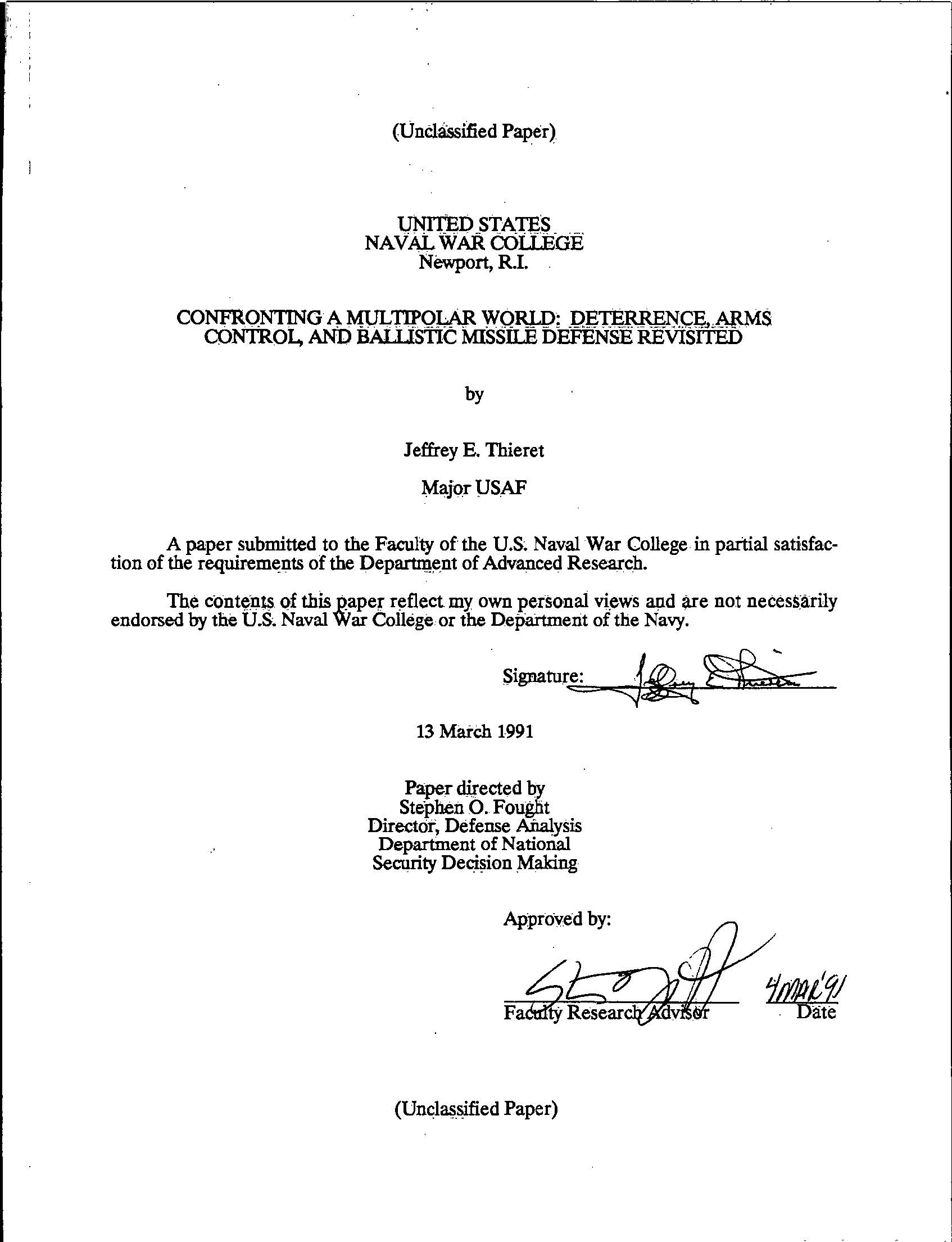Deterrence (Strategy)
Subject
Subject Source: Library of Congress Subject Headings
Found in 13 Collections and/or Records:
Arkland, Ezra H.: Escalation or brinkmanship, 1966
File — Box 252, Folder: 1
Identifier: RG-13- File N420 .F82 1966 no.17
Dates:
1966
Found in:
Naval War College Archives
/
Student papers
Bauer, Herbert: Deterrence : the role of the FBM, 1967
File — Box 268, Folder: 3
Identifier: RG-13- File N420 .F82 1967 no.5
Dates:
1967
Found in:
Naval War College Archives
/
Student papers
Blessing, George R.: Nuclear proliferation and the concept of deterrence, 1967
File — Box 268, Folder: 6
Identifier: RG-13- File N420 .F82 1967 no.10
Dates:
1967
Found in:
Naval War College Archives
/
Student papers
Confronting A Multipolar World: Deterrence, Arms Control, And Ballistic Missile Defense Revisited, 1991 Mar 31
File — Box 6-39, Folder: 3
Identifier: RG-37
Abstract
The end of the Cold War and the resultant collapse of the bipolar world order are resulting in the gradual emergence of regional Third World powers. America is left unchallenged as a global superpower, yet its national strategy must now adapt to deal with a certain degree of multipolarity based upon the regional power centers. The U.S. can achieve global security through of impellance. Impellance, which is proactive and forcible, replaces the entrenched bipolar Cold War national security strategy with a globally oriented one. The added strength of reliable alliances allows an impellant U.S. to lead a collective of nations which desire a new world order. Impellance addresses the need for increased protections against a rising ballistic missile threat in the Third World. Ballistic missile arsenals are viewed as regionally destabilizing, giving belligerent nations the ability to leapfrog over neutral or adjacent nations to inflict psychological and physical damage upon insulated states. Third World ballistic missile systems are rapidly improving through arms and technology transfers. Arms control efforts via impellent strategy, concentrating upon multiple aspects of the proliferation equation, provides both incentives and disincentives to slow the horizontal spread of technology and arms. Improved ranges and accuracies will still occur through indigenous regional improvements and natural technology transfers. Significantly improved anti-tactical ballistic missiles are needed...
Dates:
1991 Mar 31

Confronting A Multipolar World: Deterrence, Arms Control, And Ballistic Missile Defense Revisited, by Jeffrey E. Thieret
Digital Record
Identifier: RG37_06_39_03_01
Dates:
1991 Mar 31
Found in:
Naval War College Archives
Davis, Glenn A.: On strategic defense against nuclear attack, 1966
File — Box 254, Folder: 16
Identifier: RG-13- File N420 .F8 1966 no.148
Dates:
1966
Found in:
Naval War College Archives
/
Student papers
DeLong, Phillip C.: Deterrence - is not dispensable, 1967
File — Box 269, Folder: 13
Identifier: RG-13- File N420 .F8 1967 no.13
Dates:
1967
Found in:
Naval War College Archives
/
Student papers
Doyle, Lee T.: The relevance of the Gallois theories to French nuclear deterrent policy, 1968
File — Box 281, Folder: 7
Identifier: RG-13- File N420 .F8 1968 no.46
Dates:
1968
Found in:
Naval War College Archives
/
Student papers
Henderson, Eugene O'Brien: Intelligence : the ultimate deterrent, 1969
File — Box 293, Folder: 11
Identifier: RG-13- File N420 .F8 1969 no.7
Dates:
1969
Found in:
Naval War College Archives
/
Student papers
Hutchins, LaVern C.: The psycho-strategy of deterrence, 1969
File — Box 294, Folder: 15
Identifier: RG-13- File N420 .F8 1969 no.41
Dates:
1969
Found in:
Naval War College Archives
/
Student papers
